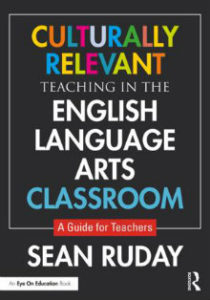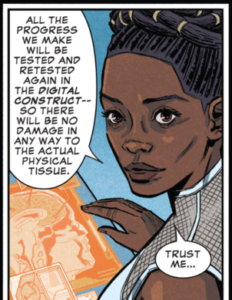Connect ELA Strategies to Life Beyond School
 By Sean Ruday
By Sean Ruday
When I began my teaching career as a seventh-grade English teacher at a public middle school in Brooklyn, I asked myself how I could incorporate my students’ out-of-school lives into my instruction in meaningful and engaging ways.
This topic has remained in the forefront of my thinking during my years as a middle school teacher, in my time as a doctoral student, and now as a college professor who trains future English and literacy teachers.
Driven by a desire to find out more about this topic, I recently conducted classroom inquiries focused on the idea of culturally relevant teaching. I spoke to teachers and students, conducted lessons with students, and analyzed the products those students created.
My goal was to provide teachers with practical suggestions for helping their students make meaningful connections between the academic concepts they learned in school and aspects of their out-of-school lives.
I’m excited to share some key recommendations for teachers interested in teaching their students how to bridge what they learn in school and what they experience in the world outside of school.
Applying Strategies to Out-of-School Contexts
To help students make these meaningful connections, I recommend asking them to apply the writing, reading, and language strategies and concepts they learn in school to out-of-school contexts and then share the results in class.
The out-of-school contexts can include any language-oriented event and use a wide range of formats – books and magazine articles are certainly included, but so are songs, television shows, text messages, social media posts, conversations, and attendance at outside events. These experiences all represent opportunities for students to apply the literacy strategies they learn in school.
This approach is effective because of the way it combines academic concepts with content students find personally meaningful. It sends the message that what may seem like isolated “school strategies” are actually tools they can use to make sense of all kinds of texts. It also encourages students to integrate their individual perspectives, identities, and backgrounds into classroom work.
By creating opportunities for students to find relevant, real-world contexts to which they can apply academic concepts and then share their findings in the classroom, we can help all students feel represented and valued.
What It Looks Like in Practice
Let’s consider some examples of what this approach can look like in practice, starting with its application to writing instruction.
I recently worked with a group of middle school students on the concept of sensory language and the ways it is used in a variety of written texts. After we discussed the concept and its importance to effective writing, I asked students to find examples of sensory language they encountered in their out-of-school lives and to reflect on the importance of that language to effective communication.
One student noted that her grandmother used a great deal of language related to the sense of smell when remembering a local festival:
“My grandma was telling me about a festival in our town and she was talking about how you could go anywhere at the festival and smell the pork barbeque and hush puppies that were being made, so there was a lot of sensory language about what she could smell.”
The student found the sensory details important to the description because they helped her clearly understand the festival:
“It was cool that [my grandmother] used this sensory language because it gave me a good understanding of what it was like there.”
This same approach can be applied to reading instruction by asking students to apply the reading strategies they learn in school to a range of texts they encounter outside of school. Students can use strategies such as identifying connections and making inferences to help them illuminate a range of print and non-print texts with which they interact.
For example, I spoke with a middle-school student who analyzed the film Black Panther by making inferences about how the main character’s ideas and perspectives changed:
“An inference I made about T’Challa, the main character, is that at the end of the movie he cares about helping people all over the world. A lot of the movie is about how Wakanda keeps to itself and doesn’t interact with other countries. At the end of the movie, though, T’Challa and his sister Shuri are in Oakland and he tells her that she’s going to be in charge of a science program there. I inferred from this that T’Challa wants to help people all over the world because he goes against how things were traditionally done in Wakanda [a policy of isolation] and that he could improve the lives of other people who need help, not just Wakandans.”
This student’s comments showed me that he applied the skills of inferential thinking to an out-of-school text by using the evidence in the film to create an inference about T’Challa’s beliefs.
In the context of language and vocabulary instruction, students can apply their knowledge of word roots to language they encounter in their out-of-school lives. After talking with students about key Greek and Latin roots, for example, teachers can ask their students to find words they notice in their daily lives that contain any of those roots, share the words they found, and explain how the root is important to the words they identified.
For example, an upper-elementary student with whom I recently worked identified a real-world application of the root “biblio,” explaining that she heard the word outside of school when her grandmother said “biblioteca,” the Spanish word for library. The student explained, “The connection between the word ‘biblioteca’ and the root ‘biblio’ is that ‘biblio’ means ‘book’ and a biblioteca, or library, is a place you’d go to borrow a book.”
Recommendations for Classroom Practice
To help students apply key strategies they learn in school to aspects of their out-of-school lives, I recommend following four instructional steps:
• Introduce the strategy to students. For example, if you’re introducing the writing strategy of using sensory details, I recommend discussing with students what sensory details are and sharing with them some examples of how this concept is used.
• Explain to students why the strategy is important. Highlight its significance to effective reading, writing, or language study. In the instance of a reading strategy such as making inferences, talk with students about how this action can enhance readers’ experiences enjoying and understanding any text. You might use examples from social media or billboards to underscore your points.
• Create opportunities for students to apply these strategies outside of school. I like to frame these opportunities as inquiries in which students look for authentic opportunities to apply their knowledge of writing concepts, reading strategies, or word roots to language/images they encounter in real-world scenarios. “The next time you go to the grocery store, look for…(e.g, deceptive language)” or “The next time you play a video game, try to identify….(e.g., character types).” Once students have conducted these inquiries, they can share their findings with the rest of the class.
• Ask students to reflect on their experiences with this process. Use questioning to help them focus on how applying their knowledge of literacy concepts to authentic situations helped them understand the concept and its relevance. “How did finding examples of this concept in your out-of-school life enhance your understanding of it?” and “How might your new insights influence your thinking in future life situations?”
By incorporating students’ experiences applying learning strategies at home, among friends, at after-school jobs, or in community settings, teachers can create inclusive classrooms that help students see themselves and their cultures reflected in their academic work.
_____________________________________







































I feel that by breaking down the walls of the classroom, students can make more connections and have meaning behind what they are doing. I do this with them by challenging them to find grammar mistakes in the real world. Whether it is a billboard, menu, marquee, or something on a website, the mistakes can be found. Thanks for sharing this post, Sean. I always love reading your insight.